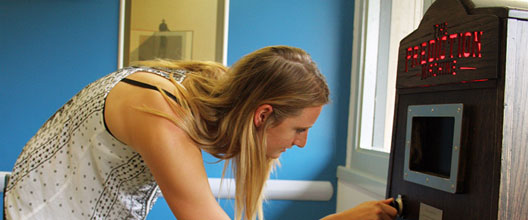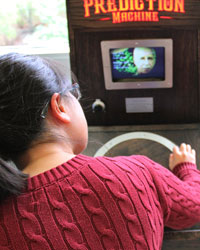
Personal climate predictions offered by new art installation

Photos care of: Julian Hughes
A new artwork unveiled at Loughborough University’s Library is predicting the future of the weather.
The Prediction Machine by Rachel Jacobs is an interactive machine which prints out personalised ‘climate fortunes’, using data collected by the University’s weather station. Inspired by end-of-the-pier fortune telling machines, The Prediction Machine tracks moments of climate change and then gives climate predictions based on the weather now and scientists’ predictions for the future.
Artist Rachel Jacobs sees the machine as a means of engaging the public with climate science and scientific data.
She comments: “It is notoriously difficult but also increasingly vital to engage the public with complex scientific issues, and especially scientific data. My research looks at how artists can play an important role in engaging the public with climate data, stimulating and shaping debate around the major science issues of our time.”
The Prediction Machine combines data received by Loughborough’s own weather station with aggregated global climate and storm data alongside predictions made by local residents. To work the machine, visitors turn a hand crank which makes videos appear on the screen, and they then pull a level to print out their prediction. A sign at the top of the machine then lights up, its intensity based on the live temperature feed from the weather station. If an extreme weather situation occurs, the sign will pulsate.
Jacobs explains: “The machine is a cross between a TV weather forecast, a fortune teller and the Tardis. When the hand crank is used, the screen powers on, ghostly faces appear and a message is transmitted disrupted by the weather data. Precipitation, temperature and wind speed all break up the video, so the more extreme the weather, the harder it is to hear and see the message. No two experiences of using the machine will be the same.”
The installation is the culmination of Nowcasting, a project linking artists with the latest thinking on meteorology, climate change and forecasting, commissioned by Radar, Loughborough University’s programme for contemporary art.
Jacobs will use her insight from the project to inform academic research looking at how artists can collaborate with scientists to increase the public’s understanding of science.
Jo Mardell, Radar Programme Co-ordinator, commented: ‘The Nowcasting commissions have really benefited from the resources and expertise at Loughborough University. Rob Wilby, Professor of Hydroclimatic Modelling within the Department of Geography, has been involved in conversations with the artists from very early stages, drawing upon his knowledge of climate variability and his breadth of experience across industry, government and academia.Rob took the time to visit Rachel in her studio whilst she was developing The Prediction Machine and some really fascinating discussions have taken place.
“Radar seeks to initiate these partnerships which allow for a mutual exchange between artists and researchers, to develop dialogues across different fields and specialisms.”
Other artists commissioned as part of Nowcasting include Alistair McClymont, who created Sun and Wind Simulacrum and Weather Record Player, a project in two phases which plays back data using domestic appliances, and James Bridle, who is creating a new online work Anti-glacier, inspired by our fragmented attention to climate change.
The Prediction Machine is at the University Library until 15 October 2014. It will then be sited at Loughborough Library on Granby Street in the town centre from 18 to 25 October 2014.